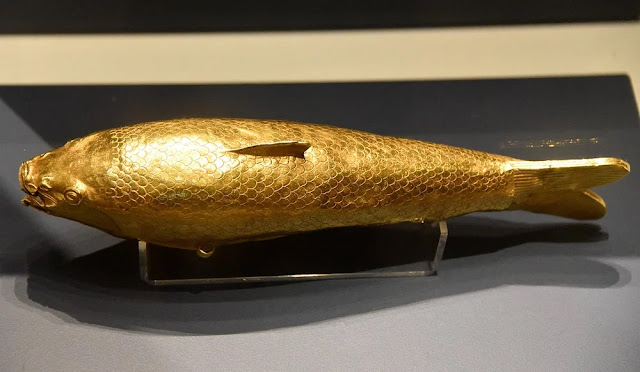 |
| This is one of a pair of golden armlets. These objects are among the most important surviving items from ancient Persian craftsmanship. It is likely that they were intended for display rather than being worn. The lion-griffin terminals were originally inlaid with precious stones, which were later removed. This inlay is typical of high-quality jewellery from this period. Part of the Oxus treasure, from Takht-i Kuwad, Tajikistan. Achaemenid Period, 5th to 4th centuries BCE. (The British Museum, London) |
The Art and Artisans of Persia
Every manner of art was practiced in our Persia. Textiles were woven and even painted with the delicate care of practiced hands. Pottery molded and hand formed fired in kilns buried at the foot of nearby mountains.. Gold and silver melded into jewelry, dinner ware, religious icons, and medals for military awards. Wood hewn and carved into intricate furniture, tools, and more.The art of Persia became known quickly. Architecture was revered. Memorials to leaders and soldiers and merchants plastered on the walls of great buildings. Great statues carved and placed throughout gardens.
In the height of Persian civility great art was shared far and wide. Gifted to great kingdoms. Traded for eastern silks and herbs. Finding a way to be delivered to the four corners of the known world.
Textiles adorned walls and windows and floors. The cotton and wools of the region blended and woven with far eastern silks made for very durable fabrics. Amazing designs and vibrant colors flowed throughout every home in the kingdom. Even clothing became art with gold and silver threads and beads and adornments prominent for all.
Precious stones were favored amoung the royal households. Intimate and delicate carvings of lions and kings and religious icons adorned turquoise and jasper mounted in silver and gold jewelry and ornaments. Royal seals were made of precious stones as well. Mounted on a staff, the royal seals were given to the care of one or two men who guarded them with their lives.
The music flowing from the lutes and drums and symbols and strings and bells was a tribute to our great culture. It was melodic. Haunting. Hypnotizing. Romantic. Enveloping. Music was not reserved for royalty and its great denizens. Music was shared from the heart with the heart of all of Persia.
 |
| Cast silver statuette of a nude youth from the Oxus Treasure. Achaemenid Period (550-330 BCE) British Museum |
 |
there is a loop intended for suspension or to attach a stopper which was later lost. The detail of the decoration suggests that it is an attempt to accurately represent a particular type of fish, perhaps a carp or a a similar species. Part of the Oxus treasure, from Takht-i Kuwad, Tajikistan. Achaemenid Period, 5th to 4th centuries BCE. (The British Museum, London) |
 |
| Gold appliques from the Oxus Treasure. Achaemenid Period (550-330 BCE). British Museum. |
Copyright 2023 Terran Cognito
